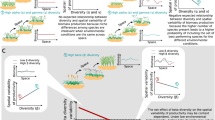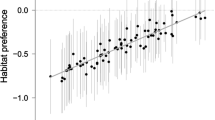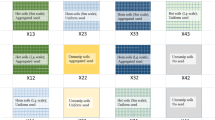Abstract
Diversity has two basic components: richness, or number of species in a given area, and evenness, or how relative abundance or biomass is distributed among species. Previously, we found that richness and evenness can be negatively related across plant communities and that evenness can account for more variation in Shannon’s diversity index (H′) than richness, which suggests that relationships among diversity components can be complex. Non-positive relationships between evenness and richness could arise due to the effects of migration rate or local species interactions, and relationships could vary depending on how these two processes structure local communities. Here we test whether diversity components are equally or differentially affected over time by changes in seed density (and associated effects on established plant density and competition) in greenhouse communities during the very early stages of community establishment. In our greenhouse experiment, we seeded prairie microcosms filled with bare field soil at three densities with draws from a mix of 22 grass and forb species to test if increased competition intensity or seedling density would affect the relationships among diversity components during early community establishment. Increased seed density treatments caused diversity components to respond in a different manner and to have different relationships with time. Richness increased linearly with seed density early in the experiment when seedling emergence was high, but was unrelated to density later in the experiment. Evenness decreased log-linearly with seed densities on all sampling dates due to a greater dominance by Rudbeckia hirta with higher densities. Early in the experiment, diversity indices weakly reflected differences in richness, but later, after the competitive effects of Rudbeckia hirta became more intense, diversity indices more strongly reflected differences in evenness. This suggests that species evenness and diversity indices do not always positively covary with richness. Based on these results, we suggest that evenness and richness can be influenced by different processes, with richness being more influenced by the number of emerging seedlings and evenness more by species interactions like competition. These results suggest that both diversity components should be measured in plant diversity studies whenever it is possible.



Similar content being viewed by others
References
Allen TFH, Wileyto EP (1983) A hierarchical model for the complexity of plant communities. J Theor Biol 101:529–540
Altesor A, DiLandro E, May H, Ezcurra E (1998) Long-term species change in a Uruguayan grassland. J Veg Sci 9:173–180
Baer SG, Blair JM, Collins SL, Knapp AK (2004) Plant community responses to resource availability and heterogeneity during restoration. Oecologia 139:617–629
Bazzaz FA (1996) Plants in changing environments. Cambridge Univ. Press
Bell G (2000) The distribution of abundance in neutral communities. Am Nat 155:606–617
Bell G (2003) The interpretation of biological surveys. Proc R Soc Lond 270:2531–2542
Biondini ME, Bonham CD, Redente EF (1985) Secondary successional patterns in a sagebrush (Artemisia tridentata) community as they relate to soil disturbance and soil biological activity. Vegetatio 60:25–36
Bowman WD, Gartner JR, Holland K, Wiedermann M (2006) Nitrogen critical loads for alpine vegetation and terrestrial ecosystem response: are we there yet? Ecol Appl 16:1183–1194
Buzas MA, Hayek LC (1996) Biodiversity resolution: an integrated approach. Biodivers Lett 3:40–43
Cahill JF, Casper BB (2002) Canopy gaps are sites of reduced belowground plant competition in a productive old field. Plant Ecol 164:29–36
Caswell H (1976) Community structure: a neutral model analysis. Ecol Mon 46:327–354
Cottingham KL, Carpenter SR (1998) Population, community, and ecosystem variates as ecological indicators: phytoplankton responses to whole-lake enrichment. Ecol Appl 8:508–530
Craine JM, Wedin DA, Chapin III FS, Reich PB (2003) Relationship between the structure of root systems and resource use for 11 North American grassland plants. Plant Ecol 165:85–100
Duncan RP, Young JR (2000) Determinants of plant extinction and rarity 145 years after European settlement of Auckland, New Zealand. Ecology 81:3048–3061
Eilers LJ, Roosa DM (1994) The vascular plants of Iowa. An annotated checklist and natural history. Univ. Iowa Press
Foster BL, Smith VH, Dickson TL, Hildebrand T (2002) Invasibility and compositional stability in a grassland community: relationships to diversity and extrinsic factors. Oikos 99:300–307
Garcia-Criado R, Tome A, Vega FJ, Antolin C (1999) Performance of some diversity and biotic indices in rivers affected by coal mining in northwestern Spain. Hydrobiologia 394:209–219
Goldberg DE, Estabrook GF (1998) Separating the effects of number of individuals sampled and competition on species diversity: an experimental and analytic approach. J Ecol 86:983–988
Gonzalez A, Chaneton EJ (2002) Heterotroph species extinction, abundance and biomass dynamics in an experimentally fragmented microecosystem. J Anim Ecol 71:594–602
Gotelli NJ, Colwell RK (2001) Quantifying biodiversity: procedures and pitfalls in the measurement and comparison of species richness. Ecol Lett 4:379–391
Grime JP (1998) Benefits of plant diversity to ecosystems: immediate, filter and founder effects. J Ecol 86:902–910
Gyedu-Ababio TK, Furstenberg JP, Baird D, Vanreusel A (1999) Nematodes as indicators of pollution: a case study from the Swartkops River system, South Africa. Hydrobiologia 397:155–169
Hayek LC, Buzas MA (1996) SHE analysis: an integrated approach to the analysis of forest biodiversity. In: Surveying Natural Populations. Columbia University Press, New York, pp. 311–321
Hill MO (1973) Diversity and evenness: a unifying notation and its consequences. Ecology 54:427–432
Howe HF (1995) Succession and fire season in experimental prairie plantings. Ecology 76:1917–1925
Hubbel SP (2001) The unified neutral theory of biodiversity and biogeography. Princeton Univ. Press
Hughes TP, Connell JH (1999) Multiple stressors on coral reefs: a long-term perspective. Limnol Oceanogr 44:932–940
Hurlbert SH (1971) The non-concept of species diversity: a critique and alternative parameters. Ecology 52:577–586
Huston MA (1994) Biological Diversity. Cambridge University Press, Cambridge, UK
Kevan PG, Greco CF, Belaoussoff S (1997) Log-normality of biodiversity and abundance in diagnosis and measuring of ecosystem health: pesticide stress on pollinators on blueberry heaths. J Appl Ecol 34:1122–1136
King AW, Pimm SL (1983) Complexity, diversity, and stability: a reconciliation of theoretical and empirical results. Am Nat 122:229–239
Klaas BA, Moloney KA, Danielson BJ (2000) The tempo and mode of gopher mound production in a tallgrass prairie remnant. Ecography 23:246–256
Lande R (1996) Statistics and partitioning of species diversity, and similarity among multiple communities. Oikos 76:5–13
Ma M (2005) Species richness vs. evenness: independent relationship and different responses to edaphic factors. Oikos 111:192–198
Magurran AE, Phillip DAT (2001) Implications of species loss in freshwater fish assemblages. Oikos 94:645–650
Magurran AE (2004) Measuring biological diversity. Blackwell Publishing, Oxford, U.K
Manier DJ, Hobbs NT (2006) Large herbivores influence the composition and diversity of shrub-steppe communities in the Rocky Mountains, USA. Oecologia 146:641–651
Martin LM, Wilsey BJ (2006) Assessing grassland restoration success: relative roles of seed additions and native ungulate grazing. J Appl Ecol. DOI 10.1111/j.1365-2664.2006.01211.x
Martin LM, Moloney KA, Wilsey BJ (2005) An assessment of grassland restoration success using species diversity components. J Appl Ecol 42:327–336
May RM (1981) Patterns in multi-species communities. In: May R (ed) Theoretical ecology, 2nd edn. Ch. 9. Blackwell Scientific Publ., Oxford, UK
McCune B, Grace JB (2002) Analysis of ecological communities. MjM Software Design, Glenedon Beach, OR
McNaughton SJ (1977) Diversity and stability of ecological communities: a comment on the role of empiricism in ecology. Am Nat 111:515–525
Mouillot D, Mason WHN, Durnay O, Wilson JB (2005) Functional regularity: a neglected aspect of functional diversity. Oecologia 142:353–359
Novecek JM, Roosa DM, Pusateri WP (1985) The vegetation of the Loess Hills land form along the Missouri River. Proc Iowa Acad Sci 92:199–212
Platt WJ, Weiss IM (1985) An experimental study of competition among fugitive prairie plants. Ecology 66:708–720
Purvis A, Hector A (2000) Review article: getting the measure of biodiversity. Nature 405:212–219
Rabinowitz D, Rapp JK (1980) Seed rain in a North American tallgrass prairie. J Appl Ecol 17:793–802
Schmitz OJ (2003) Top predator control of plant biodiversity and productivity in an old field. Ecol Lett 6:156–163
Shaffers AP (2002) Soil, biomass, and management of semi-natural vegetation. Part II. Factors controlling species diversity. Plant Ecol 158:247–268
Smith MD, Wilcox JC, Kelly T, Knapp AK (2004) Dominance not richness determines invasibility of tallgrass prairie. Oikos 106:253–262
Smith B, Wilson JB (1996) A consumer’s guide to evenness indices. Oikos 76:70–82
Spurgeon DJ, Hopkin SP (1999) Seasonal variation in the abundance, biomass and biodiversity of earthworms in soils contaminated with metal emissions from a primary smelting works. J Appl Ecol 36:173–183
Stirling G, Wilsey B (2001) Empirical relationships between species richness, evenness, and proportional diversity. Am Nat 158:86–299
Stratton DA (1995) Spatial scale of variation in fitness of Erigeron annuus. Am Nat 146:608–624
Sun GW, Coffin DP, Lauenroth WK (1997) Comparison of root distributions of species in North American grasslands using GIS. J Veg Sci 8:587–596
Tilman D (1997) Community invasibility, recruitment limitation, and grassland biodiversity. Ecology 78:81–92
Verhoef HA (1996) The role of soil microcosms in the study of ecosystem processes. Ecology 77:685–690
Weiher E, Keddy PA (1999) Relative abundance and evenness patterns along diversity and biomass gradients. Oikos 87:355–361
Wilsey BJ (2002) Clonal plants in a spatially heterogeneous environment: effects of integration on Serengeti grassland response to defoliation and urine-hits from grazing mammals. Plant Ecol 159:15–22
Wilsey BJ, Polley HW (2002) Reductions in grassland species evenness increases dicot seedling invasion and spittle bug infestation. Ecol Lett 5:676–684
Wilsey BJ, Polley HW (2004) Realistically low species evenness does not alter grassland species richness–productivity relationships. Ecology 85:2693–2701
Wilsey BJ, Chalcraft DR, Bowles CM, Willig MR (2005) Relationships among indices suggest that richness is an incomplete surrogate for grassland biodiversity. Ecology 86:1178–1184
Zobel M, Otsus M, Liira J, Moora M, Möls T (2000) Is small-scale species richness limited by seed availability or microsite availability? Ecology 81:3274–3282
Acknowledgements
We thank Brad Bauer, Dan Haug, Anna Loan-Wilsey and Leanne Martin for help with counting seedlings and processing samples. We also thank Matt Dornbush, Daniel Manier, and James Cahill for comments on an earlier version of this manuscript.
Author information
Authors and Affiliations
Corresponding author
Rights and permissions
About this article
Cite this article
Wilsey, B., Stirling, G. Species richness and evenness respond in a different manner to propagule density in developing prairie microcosm communities. Plant Ecol 190, 259–273 (2007). https://doi.org/10.1007/s11258-006-9206-4
Received:
Accepted:
Published:
Issue Date:
DOI: https://doi.org/10.1007/s11258-006-9206-4




